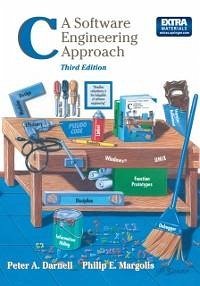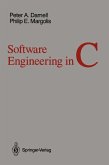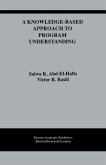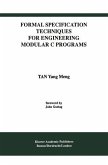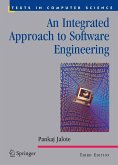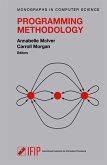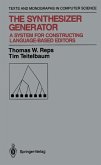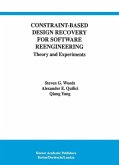40,95 €
40,95 €
inkl. MwSt.
Sofort per Download lieferbar

20 °P sammeln
40,95 €
Als Download kaufen

40,95 €
inkl. MwSt.
Sofort per Download lieferbar

20 °P sammeln
Jetzt verschenken
Alle Infos zum eBook verschenken
40,95 €
inkl. MwSt.
Sofort per Download lieferbar
Alle Infos zum eBook verschenken

20 °P sammeln
- Format: PDF
- Merkliste
- Auf die Merkliste
- Bewerten Bewerten
- Teilen
- Produkt teilen
- Produkterinnerung
- Produkterinnerung

Bitte loggen Sie sich zunächst in Ihr Kundenkonto ein oder registrieren Sie sich bei
bücher.de, um das eBook-Abo tolino select nutzen zu können.
Hier können Sie sich einloggen
Hier können Sie sich einloggen
Sie sind bereits eingeloggt. Klicken Sie auf 2. tolino select Abo, um fortzufahren.

Bitte loggen Sie sich zunächst in Ihr Kundenkonto ein oder registrieren Sie sich bei bücher.de, um das eBook-Abo tolino select nutzen zu können.
This highly readable text provides an introductory course on programming in C.The authors emphasize the importance of good programming practice and the use of sound software engineering principles to develop programs which are readable, maintainable, portable, and efficient. "Outstanding textbook for novice C users" Computer Book Reviews
- Geräte: PC
- ohne Kopierschutz
- eBook Hilfe
- Größe: 46.5MB
Andere Kunden interessierten sich auch für
![Software Engineering in C (eBook, PDF) Software Engineering in C (eBook, PDF)]() Peter A. DarnellSoftware Engineering in C (eBook, PDF)40,95 €
Peter A. DarnellSoftware Engineering in C (eBook, PDF)40,95 €![A Knowledge-Based Approach to Program Understanding (eBook, PDF) A Knowledge-Based Approach to Program Understanding (eBook, PDF)]() Salwa K. Abd-El-HafizA Knowledge-Based Approach to Program Understanding (eBook, PDF)72,95 €
Salwa K. Abd-El-HafizA Knowledge-Based Approach to Program Understanding (eBook, PDF)72,95 €![Formal Specification Techniques for Engineering Modular C Programs (eBook, PDF) Formal Specification Techniques for Engineering Modular C Programs (eBook, PDF)]() Tan Yang MengFormal Specification Techniques for Engineering Modular C Programs (eBook, PDF)112,95 €
Tan Yang MengFormal Specification Techniques for Engineering Modular C Programs (eBook, PDF)112,95 €![An Integrated Approach to Software Engineering (eBook, PDF) An Integrated Approach to Software Engineering (eBook, PDF)]() Pankaj JaloteAn Integrated Approach to Software Engineering (eBook, PDF)58,95 €
Pankaj JaloteAn Integrated Approach to Software Engineering (eBook, PDF)58,95 €![Programming Methodology (eBook, PDF) Programming Methodology (eBook, PDF)]() Programming Methodology (eBook, PDF)72,95 €
Programming Methodology (eBook, PDF)72,95 €![The Synthesizer Generator (eBook, PDF) The Synthesizer Generator (eBook, PDF)]() Thomas W. RepsThe Synthesizer Generator (eBook, PDF)40,95 €
Thomas W. RepsThe Synthesizer Generator (eBook, PDF)40,95 €![Constraint-Based Design Recovery for Software Reengineering (eBook, PDF) Constraint-Based Design Recovery for Software Reengineering (eBook, PDF)]() Steven G. WoodsConstraint-Based Design Recovery for Software Reengineering (eBook, PDF)160,95 €
Steven G. WoodsConstraint-Based Design Recovery for Software Reengineering (eBook, PDF)160,95 €-
-
-
This highly readable text provides an introductory course on programming in C.The authors emphasize the importance of good programming practice and the use of sound software engineering principles to develop programs which are readable, maintainable, portable, and efficient. "Outstanding textbook for novice C users" Computer Book Reviews
Dieser Download kann aus rechtlichen Gründen nur mit Rechnungsadresse in A, B, BG, CY, CZ, D, DK, EW, E, FIN, F, GR, HR, H, IRL, I, LT, L, LR, M, NL, PL, P, R, S, SLO, SK ausgeliefert werden.
Produktdetails
- Produktdetails
- Verlag: Springer US
- Seitenzahl: 498
- Erscheinungstermin: 6. Dezember 2012
- Englisch
- ISBN-13: 9781461240204
- Artikelnr.: 44063666
- Verlag: Springer US
- Seitenzahl: 498
- Erscheinungstermin: 6. Dezember 2012
- Englisch
- ISBN-13: 9781461240204
- Artikelnr.: 44063666
- Herstellerkennzeichnung Die Herstellerinformationen sind derzeit nicht verfügbar.
1: Introduction to Programming.- 1.1 High-Level Programming Languages.- 1.2 History of C.- 1.3 ANSI and ISO Standards.- 1.4 Nature of C.- 2: Introduction to Software Engineering.- 2.1 Introduction.- 2.2 Stages of Software Production.- 2.3 Product Specification.- 2.4 Architectural Design.- 2.5 Project Planning.- 2.6 Detailed Design.- 2.7 Coding.- 2.8 Debugging.- 2.9 Testing.- 2.10 Maintenance.- 2.11 The Bridge Metaphor.- 3: C Essentials.- 3.1 Program Development.- 3.2 Functions.- 3.3 Variables and Constants.- 3.4 Names.- 3.5 Expressions.- 3.6 Formatting Source Files.- 3.7 The main() Function.- 3.8 The printf() Function.- 3.9 The scanf() Function.- 3.10 The Preprocessor.- 3.11 Exercises.- 4: Scalar Data Types.- 4.1 Declarations.- 4.2 Different Kinds of Integer Constants.- 4.3 Floating-Point Types.- 4.4 Scientific Notation.- 4.5 Initialization.- 4.6 Mixing Types.- 4.7 Explicit Conversions-Casts.- 4.8 Enumeration Types.- 4.9 The void Data Type.- 4.10 Typedefs.- 4.11 Finding the Address of an Object.- 4.12 Introduction to Pointers.- 4.13 Exercises.- 5: Control Flow.- 5.1 Conditional Branching.- 5.2 The switch Statement.- 5.3 Looping.- 5.4 Nested Loops.- 5.5 A Simple Calculator Program.- 5.6 The break and continue Statements.- 5.7 The goto Statement.- 5.8 Infinite Loops.- 5.9 Exercises.- 6: Operators and Expressions.- 6.1 Precedence and Associativity.- 6.2 Unary Plus and Minus Operators.- 6.3 Binary Arithmetic Operators.- 6.4 Arithmetic Assignment Operators.- 6.5 Increment and Decrement Operators.- 6.6 Comma Operator.- 6.7 Relational Operators.- 6.8 Logical Operators.- 6.9 Bit-Manipulation Operators.- 6.10 Bitwise Assignment Operators.- 6.11 Cast Operator.- 6.12 sizeof Operator.- 6.13 Conditional Operator (?:).- 6.14 Memory Operators.- 6.15 Exercises.- 7: Arrays andPointers.- 7.1 Declaring an Array.- 7.2 How Arrays Are Stored in Memory.- 7.3 Initializing Arrays.- 7.4 Example: Encryption and Decryption.- 7.5 Pointer Arithmetic.- 7.6 Passing Pointers as Function Arguments.- 7.7 Accessing Array Elements Through Pointers.- 7.8 Passing Arrays as Function Arguments.- 7.9 Sorting Algorithms.- 7.10 Strings.- 7.11 Multidimensional Arrays.- 7.12 Arrays of Pointers.- 7.13 Pointers to Pointers.- 7.14 Exercises.- 8: Storage Classes.- 8.1 Fixed vs. Automatic Duration.- 8.2 Scope.- 8.3 Global Variables.- 8.4 The register Specifier.- 8.5 The const Storage-Class Modifier.- 8.6 The volatile Storage-Class Modifier.- 8.7 Summary of Storage Classes.- 8.8 Dynamic Memory Allocation.- 8.9 Exercises.- 9: Structures and Unions.- 9.1 Structures.- 9.2 Linked Lists.- 9.3 Unions.- 9.4 enum Declarations.- 9.5 Exercises.- 10: Functions.- 10.1 Passing Arguments.- 10.2 Declarations and Calls.- 10.3 Pointers to Functions.- 10.4 Recursion.- 10.5 The main() Function.- 10.6 Complex Declarations.- 10.7 Exercises.- 11: The C Preprocessor.- 11.1 Macro Substitution.- 11.2 Conditional Compilation.- 11.3 Include Facility.- 11.4 Line Control.- 11.5 Exercises.- 12: Input and Output.- 12.1 Streams.- 12.2 Buffering.- 12.3 The Header File.- 12.4 Opening and Closing a File.- 12.5 Reading and Writing Data.- 12.6 Selecting an I/O Method.- 12.7 Unbuffered I/O.- 12.8 Random Access.- 12.9 Exercises.- 13: Software Engineering-A Case Study.- 13.1 Style Review.- 13.2 Product Specification.- 13.3 Architectural Design.- 13.4 Project Planning.- 13.5 Detailed Design.- 13.6 Software Tools for Software Production.- 13.7 Documentation.- 13.8 Exercises.- Appendices.- A: The ANSI Runtime Library.- A.1 Function Names.- A.2 Header Files.- A.3 Synopses.- A.4 Functions vs. Macros.- A.5 ErrorHandling.- A.6 Diagnostics.- A.7 Character Handling.- A.8 Setting Locale Parameters.- A.9 Mathematics.- A.10 Nonlocal Jumps.- A.11 Signal Handling.- A.12 Variable Argument Lists.- A.13 I/O Functions.- A.14 General Utilities.- A.15 String-Handling Functions.- A.16 Multibyte Character Functions.- A.17 Date and Time Functions.- B: Implementation Limits.- B.1 Translation Limits.- B.2 Numerical Limits.- C: Differences Between the ANSI and K&R Standards.- C.1 Source Translation Differences.- C.2 Data Type Differences.- C.3 Statement Differences.- C.4 Expression Differences.- C.5 Storage Class and Initialization Differences.- C.6 Preprocessor Differences.- D: Reserved Names.- E: ASCII Codes.
1: Introduction to Programming.- 1.1 High-Level Programming Languages.- 1.2 History of C.- 1.3 ANSI and ISO Standards.- 1.4 Nature of C.- 2: Introduction to Software Engineering.- 2.1 Introduction.- 2.2 Stages of Software Production.- 2.3 Product Specification.- 2.4 Architectural Design.- 2.5 Project Planning.- 2.6 Detailed Design.- 2.7 Coding.- 2.8 Debugging.- 2.9 Testing.- 2.10 Maintenance.- 2.11 The Bridge Metaphor.- 3: C Essentials.- 3.1 Program Development.- 3.2 Functions.- 3.3 Variables and Constants.- 3.4 Names.- 3.5 Expressions.- 3.6 Formatting Source Files.- 3.7 The main() Function.- 3.8 The printf() Function.- 3.9 The scanf() Function.- 3.10 The Preprocessor.- 3.11 Exercises.- 4: Scalar Data Types.- 4.1 Declarations.- 4.2 Different Kinds of Integer Constants.- 4.3 Floating-Point Types.- 4.4 Scientific Notation.- 4.5 Initialization.- 4.6 Mixing Types.- 4.7 Explicit Conversions-Casts.- 4.8 Enumeration Types.- 4.9 The void Data Type.- 4.10 Typedefs.- 4.11 Finding the Address of an Object.- 4.12 Introduction to Pointers.- 4.13 Exercises.- 5: Control Flow.- 5.1 Conditional Branching.- 5.2 The switch Statement.- 5.3 Looping.- 5.4 Nested Loops.- 5.5 A Simple Calculator Program.- 5.6 The break and continue Statements.- 5.7 The goto Statement.- 5.8 Infinite Loops.- 5.9 Exercises.- 6: Operators and Expressions.- 6.1 Precedence and Associativity.- 6.2 Unary Plus and Minus Operators.- 6.3 Binary Arithmetic Operators.- 6.4 Arithmetic Assignment Operators.- 6.5 Increment and Decrement Operators.- 6.6 Comma Operator.- 6.7 Relational Operators.- 6.8 Logical Operators.- 6.9 Bit-Manipulation Operators.- 6.10 Bitwise Assignment Operators.- 6.11 Cast Operator.- 6.12 sizeof Operator.- 6.13 Conditional Operator (?:).- 6.14 Memory Operators.- 6.15 Exercises.- 7: Arrays andPointers.- 7.1 Declaring an Array.- 7.2 How Arrays Are Stored in Memory.- 7.3 Initializing Arrays.- 7.4 Example: Encryption and Decryption.- 7.5 Pointer Arithmetic.- 7.6 Passing Pointers as Function Arguments.- 7.7 Accessing Array Elements Through Pointers.- 7.8 Passing Arrays as Function Arguments.- 7.9 Sorting Algorithms.- 7.10 Strings.- 7.11 Multidimensional Arrays.- 7.12 Arrays of Pointers.- 7.13 Pointers to Pointers.- 7.14 Exercises.- 8: Storage Classes.- 8.1 Fixed vs. Automatic Duration.- 8.2 Scope.- 8.3 Global Variables.- 8.4 The register Specifier.- 8.5 The const Storage-Class Modifier.- 8.6 The volatile Storage-Class Modifier.- 8.7 Summary of Storage Classes.- 8.8 Dynamic Memory Allocation.- 8.9 Exercises.- 9: Structures and Unions.- 9.1 Structures.- 9.2 Linked Lists.- 9.3 Unions.- 9.4 enum Declarations.- 9.5 Exercises.- 10: Functions.- 10.1 Passing Arguments.- 10.2 Declarations and Calls.- 10.3 Pointers to Functions.- 10.4 Recursion.- 10.5 The main() Function.- 10.6 Complex Declarations.- 10.7 Exercises.- 11: The C Preprocessor.- 11.1 Macro Substitution.- 11.2 Conditional Compilation.- 11.3 Include Facility.- 11.4 Line Control.- 11.5 Exercises.- 12: Input and Output.- 12.1 Streams.- 12.2 Buffering.- 12.3 The Header File.- 12.4 Opening and Closing a File.- 12.5 Reading and Writing Data.- 12.6 Selecting an I/O Method.- 12.7 Unbuffered I/O.- 12.8 Random Access.- 12.9 Exercises.- 13: Software Engineering-A Case Study.- 13.1 Style Review.- 13.2 Product Specification.- 13.3 Architectural Design.- 13.4 Project Planning.- 13.5 Detailed Design.- 13.6 Software Tools for Software Production.- 13.7 Documentation.- 13.8 Exercises.- Appendices.- A: The ANSI Runtime Library.- A.1 Function Names.- A.2 Header Files.- A.3 Synopses.- A.4 Functions vs. Macros.- A.5 ErrorHandling.- A.6 Diagnostics.- A.7 Character Handling.- A.8 Setting Locale Parameters.- A.9 Mathematics.- A.10 Nonlocal Jumps.- A.11 Signal Handling.- A.12 Variable Argument Lists.- A.13 I/O Functions.- A.14 General Utilities.- A.15 String-Handling Functions.- A.16 Multibyte Character Functions.- A.17 Date and Time Functions.- B: Implementation Limits.- B.1 Translation Limits.- B.2 Numerical Limits.- C: Differences Between the ANSI and K&R Standards.- C.1 Source Translation Differences.- C.2 Data Type Differences.- C.3 Statement Differences.- C.4 Expression Differences.- C.5 Storage Class and Initialization Differences.- C.6 Preprocessor Differences.- D: Reserved Names.- E: ASCII Codes.
